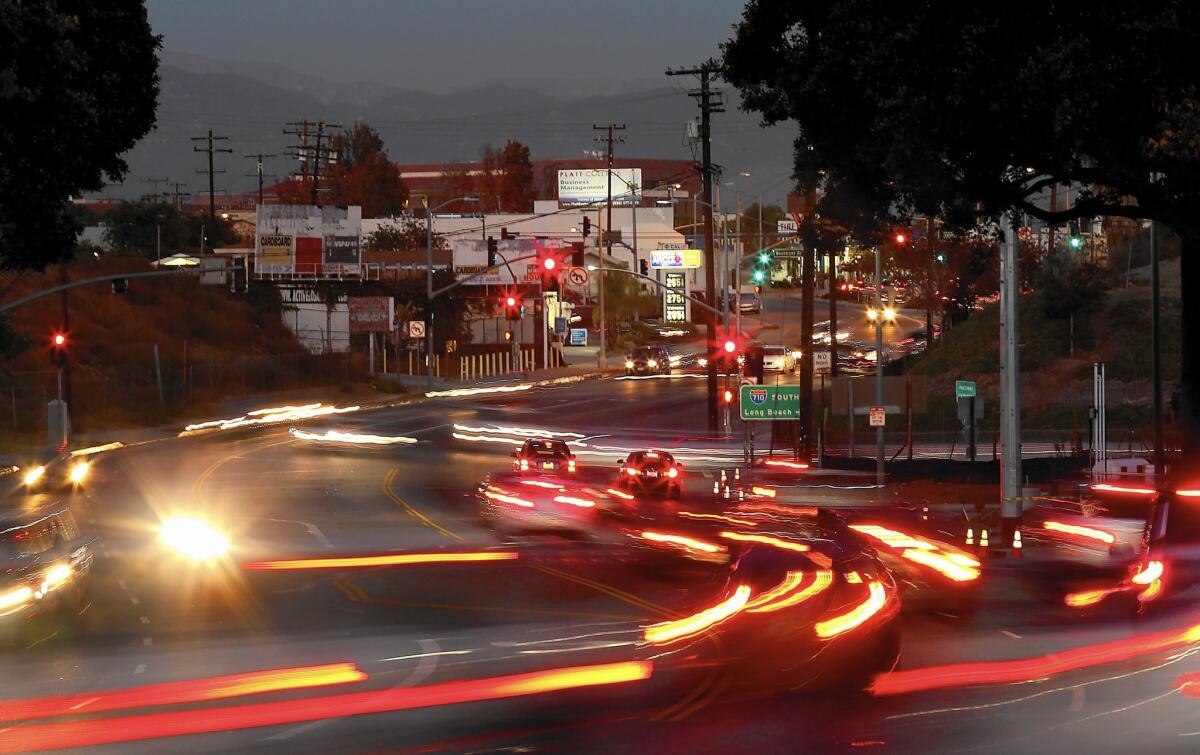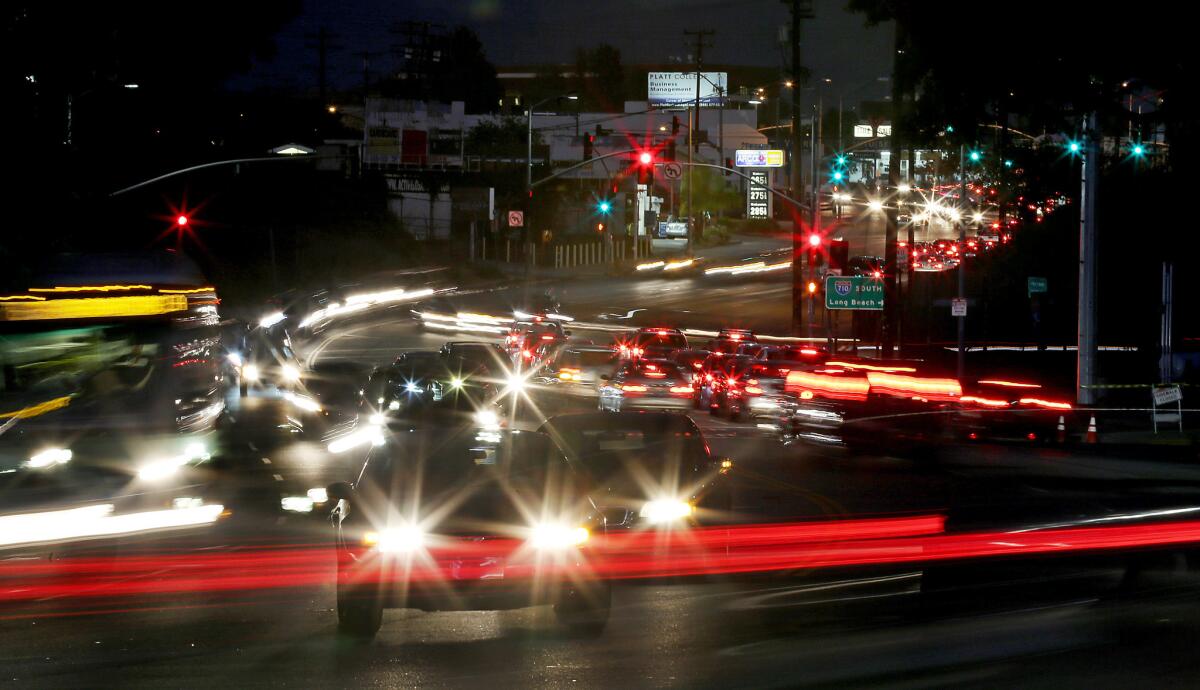Here are better ideas for the land Caltrans has stockpiled for the 710 Freeway extension

Weâre having the wrong debate about the 710 Freeway.
To put it another way: The debate weâre having about the 710 Freeway should be a whole lot broader and more imaginative than itâs been so far.
State and local transportation planners announced last year that they were finally abandoning the controversial idea of building an aboveground extension of the 710 through Pasadena and South Pasadena. In its place they presented five options, including adding new transit lines or building the roadway as a five-mile, $5.6-billion tunnel.
SIGN UP for the free Essential Arts & Culture newsletter >>
The discussion thatâs followed has focused largely on the tunnel. Opponents have called it staggeringly expensive and suggested building it would produce years of disruption. Supporters have identified it as a key missing north-south link in the Southern California transportation network, filling a gap between the 10 and the 210 freeways and offering overdue relief to Alhambra and other cities overrun with traffic pouring off the truncated 710.
But as those arguments have raged, weâve let one big question slip from the agenda: What should Caltrans do with the property it has been stockpiling on the aboveground 710 corridor for more than four decades?
Over that time the agency acquired about 400 residential properties, most of them single-family houses, that it planned to demolish to make way for the freeway. It also owns nearly 60 vacant residential lots as well as several large open pieces of land, many alongside, between or near freeway ramps at each end of the corridor.
Once the aboveground 710 was officially dropped as an option, Caltrans started the process of putting those houses on the market.
It said it planned to sell them in batches over time, beginning with a group of about 50 early next year, to avoid flooding the market and depressing their value. It also said current tenants would have first crack at buying the houses, as long as they could pay what Caltrans terms âappraised fair market value.â
But owning all those houses and all that empty land is not a burden for Caltrans. Itâs an opportunity. In fact, in a region desperately short on park space and affordable housing, itâs a big and rare one.

There is a dedicated group of homeowners and public officials, particularly in Pasadena and South Pasadena, who have been actively engaged in fighting the 710 extension for years.
Instead of letting the property it controls melt back into the private realm, the agency should work with Los Angeles County and the state of California to build a combination of new parks and affordable and market-rate housing in the 710 corridor. New bike and walking paths could lead to the Arroyo Seco and rail stations on the Gold Line, helping stitch back together neighborhoods long separated by a no-manâs land set aside for freeway construction.
If the tunnel plan is ultimately shelved, as many have predicted, large pieces of open land would become available for new uses, including a sunken green space in Pasadena stretching north from California Boulevard to the edge of the Old Town shopping district. That land, like acreage near the corridorâs southern end, could accommodate apartment buildings as well as arrays of solar panels or space for capturing and treating storm water.
A few ideas similar to these, at least in spirit, are included in a recent proposal from a coalition called Beyond the 710, created by the cities of Glendale, Pasadena, South Pasadena and others. But it has little to say about affordable housing or rethinking the plan to sell Caltrans property.
And it can be hard to tell where its interest in the aboveground route ends and its fierce opposition to the tunnel begins. Better to keep the two issues separate.
When it comes to putting together plans for new housing, many dense cities and counties face one primary obstacle: They donât control enough land suitable for new residential construction to put even a small dent in housing prices or the lack of supply.
Los Angeles County, thanks to those Caltrans acquisitions, is already sitting on a significant land bank â and in a part of the county where demand and prices for housing are high. Now the question is how best to spend its contents.
The planning would need to proceed in two phases. Because sales of houses in the 710 corridor were authorized by an act of the state Legislature, it will take another piece of legislation in Sacramento to put them on hold.
Legislators might ultimately decide to sell some of the more valuable houses. In fact, one advantage of this new vision for the 710 corridor is that it that could largely finance itself, with certain houses or limited open acreage sold to developers to help pay for the more ambitious improvements.
Next the action will need to move to the county level because the corridor moves through several cities, including Alhambra, South Pasadena, Pasadena and the El Sereno section of Los Angeles.
Working with Sacramento and Metro, the transit agency that has taken over planning for the 710 tunnel, the county Board of Supervisors should organize an invited master-plan competition that includes the Caltrans houses and open land once set aside for the freeway. It should require that the proposals include ideas for keeping many of the houses zoned single-family while subdividing larger ones for multi-family housing â and that new revenue be used in part to mitigate the social and environmental damage caused to Alhambra and other cities near the southern end of the corridor.
Some of the vacant parcels might be used for demonstration houses or apartments, prototypes exploring new ways for residential architecture to collect rainwater, save energy or allow retirees to age in place. Others might be ideal for testing out new partnerships between cities in the corridor and local architecture schools, following the example of programs at Yale and the University of Kansas that have produced well-designed low-cost housing while giving students a rare kind of political and practical experience.
Los Angeles and Southern California have been wary of ambitious plans for affordable housing since at least the 1950s, when the predominantly Mexican American Chavez Ravine neighborhood was razed to make way for a proposed collection of apartment buildings by architects Richard Neutra and Robert E. Alexander. When that plan became politically controversial, it was abandoned and Dodger Stadium was built on the newly cleared site instead.
But there is also a rich heritage of architecturally innovative housing in Los Angeles that is modest in scale and elegantly woven into gardens by architects including Neutra, Paul R. Williams and Irving Gill.
New housing in the 710 corridor would do more than just copy those earlier models. Because Caltrans owns property in several sections of the route, any new plan would be at least in part a distributed one. Instead of a single monolithic project ringed by green space, innovative new housing and parks could be built at a range of scales, designed by a diverse group of architects and scattered throughout several cities.
Just as important, the plan would signal that Caltrans, whose freeway construction projects have so often divided cities and neighborhoods, is serious about taking steps to reconnect them.
There is a dedicated group of homeowners and public officials, particularly in Pasadena and South Pasadena, who have been actively engaged in fighting the 710 extension for years.
But theyâd been expecting a roaring freeway. A necklace of new parks and walking paths dotted with limited and well-designed new housing is a far more attractive prospect.
More to the point, it is not enough to oppose the 710 extension simply by arguing for the status quo. Rising income inequality and homelessness, an acute shortage of park space in Los Angeles County and the need for new approaches to energy and water policy in an era of climate change: The pressing nature of each of these issues means that alongside impassioned statements about what shouldnât be built we need to hear wide-ranging ideas about what should be.
It would be naive to see the 710 corridor, by itself, as the place to solve these problems. But the land could operate as a proving ground, a public-works engine designed to test innovative strategies for addressing each of them.
ALSO:
$1.14 billion later, expanded 405 Freeway is a hodgepodge of design
Mobility Plan 2035 may be the cornerstone of a new L.A.
Petersen Automotive Museumâs new look conveys a happily tasteless exterior
More to Read
The biggest entertainment stories
Get our big stories about Hollywood, film, television, music, arts, culture and more right in your inbox as soon as they publish.
You may occasionally receive promotional content from the Los Angeles Times.











